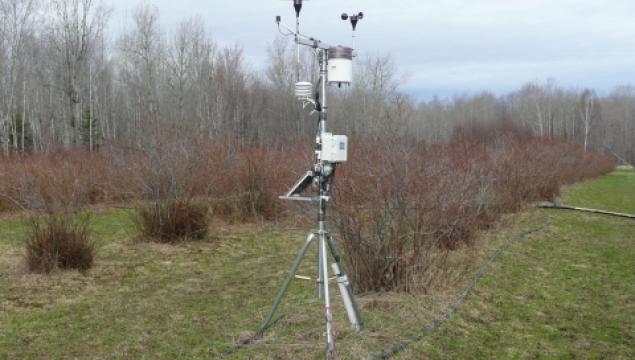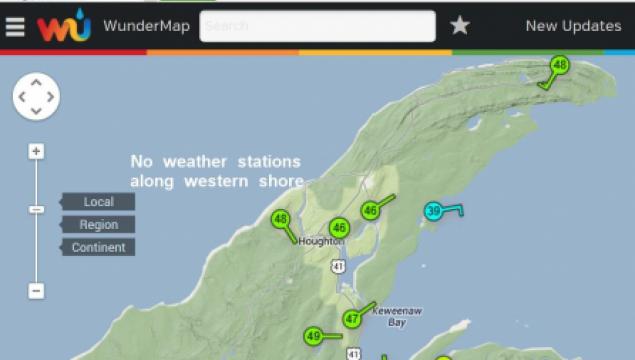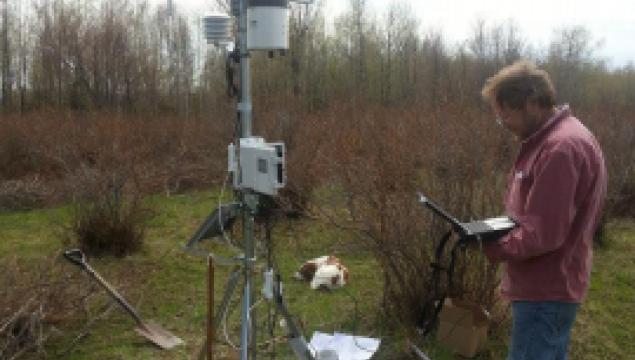Real-Time Weather Station for Climate Research on the Keweenaw Peninsula
Why This Project Is Important
The “lake effect” on temperature is strongly impacted by local geography and terrain, with noticeably cooler temperatures on windward shores in summer. Although professional-grade weather stations have been established on the eastern side of the Keweenaw Peninsula, no instruments are located on the western, windward side. Making comparisons in the weather and climate across a region requires that the instrumentation and configuration be identical; for example, temperature sensors must be the same height above the ground and must measure and record information at exactly the same time. Standardization allows for regional analysis of data collected as part of an environmental monitoring system, and allows us to assess the impact of predicted lake warming on terrestrial climate.
Project Description
Keweenaw residents are aware of the lake effect and its impact on snow accumulation patterns, air temperature and wind velocity. The effect on air temperature depends on the prevailing direction of the wind and distance from the shore, with more pronounced cooling on the western, windward side of the peninsula. Ongoing studies at the Huron Mountain Club, north of Marquette, have shown that the air temperature averages 4 degrees F colder near the shore during spring and summer, but 2 degrees F warmer in winter, if the lake remains ice-free. Accurate weather data provide an objective means to characterize climate trends, and strategic siting of instruments allows us to assess geographic patterns and variations.
Currently, we have two professional-grade weather stations along the western side of Keweenaw Bay that are monitoring the strong climate gradients; the near-real time data is displayed on WeatherUnderground for recreational use, public safety, and to help local farmers and home-based growers optimize planting and irrigation (see WeatherUnderground and view the “Keweenaw Bay West Shore” and “Gierke Blueberry Farm” sites). We seek to expand the network by installing a professional-grade weather station on the western shore of the Keweenaw Peninsula, where no data is currently being collected. Careful studies of weather and climate will help us decipher the complex lake-land interactions and provide the high-quality data needed to track the effects of climate change.
Meet the Researcher

Ken Hinkel
I am a graduate of the Department of Geological Sciences at the University of Michigan, and am currently a professor of Earth Sciences at the University of Cincinnati. Most of my research in conducted in the Arctic, where I study the effects of climate warming on permafrost, hydrology, the landscape and the indigenous people. I have had research sites in the UP of Michigan for over 10 years, looking at the impact of Lake Superior on temperature and microclimate. When not in the Arctic, my wife and I spend our summers at our cottage on Keweenaw Bay.
days left
funded
last
What Your Donation Can Help Us Do:
- Provide for a professional-grade weather station on the western shore of the Keweenaw Peninsula
- Assess the long-term impact of lake warming on terrestrial climate
- Make near real-time information from the weather network accessible to the public
Recent Donors
Some donors may be hidden.




 Gifts to projects listed on SUPERIORIDEAS.ORG are received and processed by Michigan Tech Fund. Michigan Tech Fund is a tax-exempt organization under Section 501(c)(3) of the Internal Revenue Code acting on behalf of Michigan Technological University. It is the policy of Michigan Tech Fund that a portion of the gifts and/or income therefrom may be used to defray the costs of raising and administering the funds.
Gifts to projects listed on SUPERIORIDEAS.ORG are received and processed by Michigan Tech Fund. Michigan Tech Fund is a tax-exempt organization under Section 501(c)(3) of the Internal Revenue Code acting on behalf of Michigan Technological University. It is the policy of Michigan Tech Fund that a portion of the gifts and/or income therefrom may be used to defray the costs of raising and administering the funds.
Questions for the Researcher